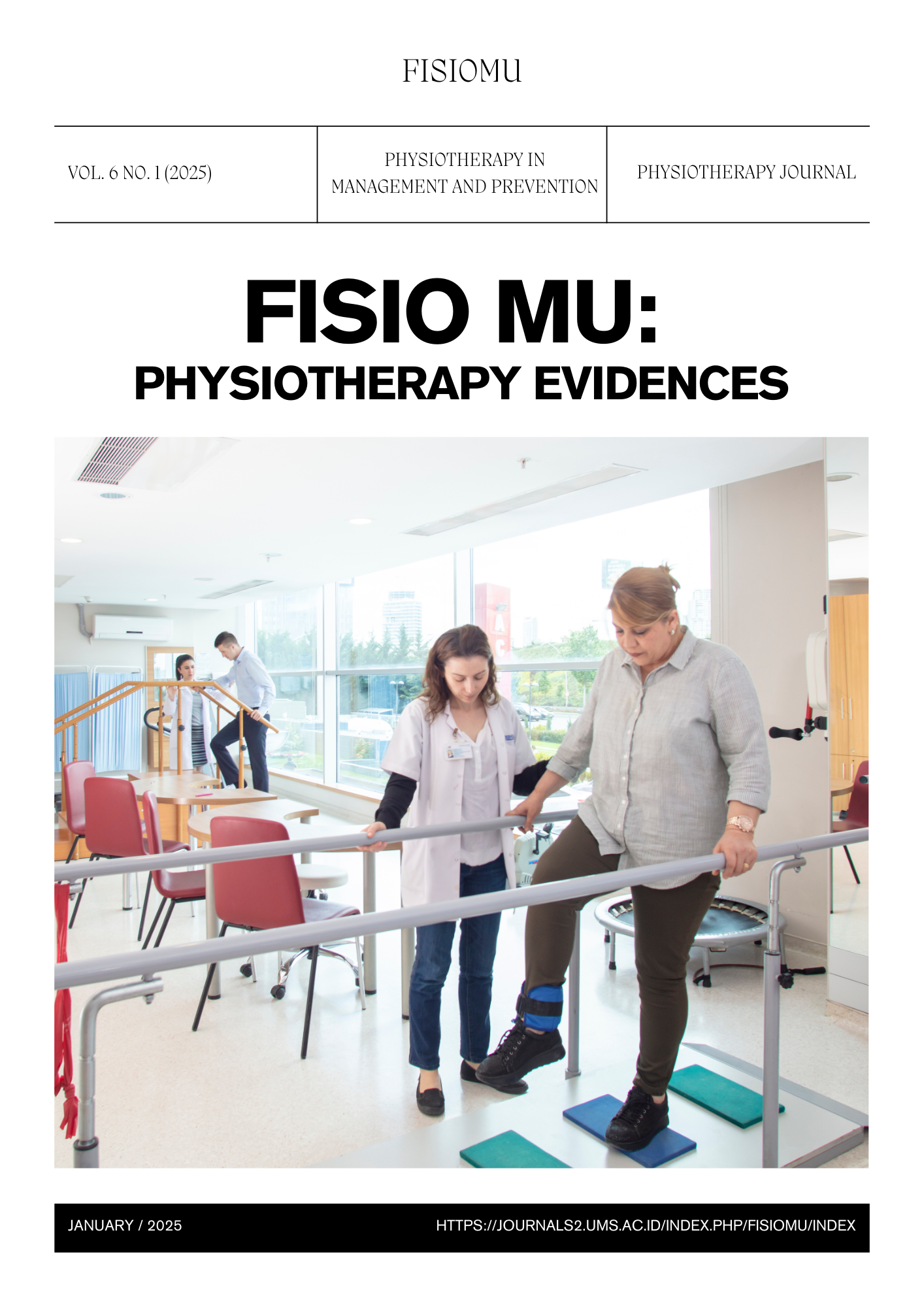The Impact Of Lumbar Stabilization Exercise On The Quality Of Life Of Pregnancy-Related Back Pain
DOI:
https://doi.org/10.23917/fisiomu.v6i1.7471Keywords:
Lumbar Stabilization, Exercise , Quality Of Life , Pregnancy , Back PainAbstract
Introduction: The developmental process of the fetus disrupts the daily activities of pregnant women, leading to musculoskeletal system disorders, mainly back pain. Fetal development causes postural changes and a shift in the body's centre of gravity to the anterior of the pregnant woman, resulting in paraspinal muscle tension and abdominal muscle weakness. Ignoring back discomfort during pregnancy can negatively affect a woman's overall health and happiness. Lumbar Stabilization Exercises are physical activities that aim to enhance neuromuscular function, strengthen the lower back, and improve flexibility, all of which contribute to maintaining spinal stability. This study aims to determine the effect of lumbar stabilisation exercise on the quality of life of pregnant women experiencing discomfort from back pain. Methods: The subjects of this study are pregnant women located at the Puskesmas Kartasura worksite who experience complaints of back pain. We assigned 11 respondents to the treatment group who underwent the exercise therapy known as LSE. We assigned another 11 respondents to the control group, who attended prenatal classes either in the village or at the clinic. We used the WHOQOOL Bref-Ina as the quality-of-life questionnaire. The data analysis involved using univariate analysis, normality tests, homogeneity tests, influence tests, and difference tests. Results: This study found that Lumbar Stabilization Exercise (LSE) affects the quality of life of pregnant women who report back pain (p = 0.000); however, there is no statistically significant difference (p = 0.902) between the treatment group and the control group. Conclusion: Lumbar Stabilization Exercises (LSE) effectively improve the quality of life for pregnant women experiencing back pain, as evidenced by significant improvements in physical, psychological, social, and environmental domains.
Downloads
References
Anggasari, Y. (2021) ‘Pengaruh Antara Keteraturan Prenatal Gentle Yoga Terhadap Penurunan Tingkat Nyeri Pinggang Pada Ibu Hamil Trimester Iii’, Midwifery Journal: Jurnal Kebidanan UM. Mataram, 6(1), p. 34. Available at: https://doi.org/10.31764/mj.v6i1.1408. DOI: https://doi.org/10.31764/mj.v6i1.1408
Arummega, M.N., Rahmawati, A. and Meiranny, A. (2022) ‘Faktor-Faktor yang Mempengaruhi Nyeri Punggung Ibu Hamil Trimester III: Literatur Review’, Oksitosin : Jurnal Ilmiah Kebidanan, 9(1), pp. 14–30. Available at: https://doi.org/10.35316/oksitosin.v9i1.1506. DOI: https://doi.org/10.35316/oksitosin.v9i1.1506
Astuti, Y. and Afsah, R. (2019) ‘Peningkatan Kesejahteraan Ibu Hamil dengan Prenatal Yoga’, 08(01), pp. 47–53. DOI: https://doi.org/10.29405/solma.v8i1.2966
B, R. and D, Komalasari, et al (2022) ‘HUBUNGAN KESEIMBANGAN TUBUH DAN KEBUGARAN FISIK TERHADAP KUALITAS HIDUP PADA LANJUT USIA DI DAERAH URBAN SURAKARTA’, 4, pp. 1839– 1849. DOI: https://doi.org/10.33024/mnj.v4i7.6906
Bahadoran, P. and Mohamadirizi, S. (2015) ‘Relationship between physical activity and quality of life in pregnant women’, 20(2), pp. 282–286.
Casagrande, D.M. et al. (2015) ‘539.Full-2’, 23(9), pp. 539–549. DOI: https://doi.org/10.5435/JAAOS-D-14-00248
Devi, Ip.K. and Nurul, W.M. (2019) ‘GAMBARAN NYERI PUNGGUNG BAWAH PADA IBU HAMIL TRIMESTER III’, 3, pp. 352–361. DOI: https://doi.org/10.31539/jks.v3i1.512
Emília, M. et al. (2017) ‘Back Pain During Pregnancy’, Journal of midwifery & women’s health, 62(1), pp. 135–136. Available at: https://doi.org/10.1111/jmwh.12597. DOI: https://doi.org/10.1111/jmwh.12597
Fatmarizka, T., Khasanah, D.A. and Arwida, N. (2021) ‘Prevalensi pola keluhan nyeri punggung pada ibu hamil di Puskesmas Kartasura’, 1(2), pp. 64–67. Available at: https://doi.org/10.31101/jitu.2415. DOI: https://doi.org/10.31101/jitu.2415
Fenti, H. (2020) Metode Penelitian.
Fithriyah, Dyah, H.R. and Sari, D.R. (2020) ‘PENGARUH PRENATAL MASSAGE TERHADAP PENURUNAN NYERI PUNGGUNG PADA IBU HAMIL TRIMESTER III’, 10(1), pp. 36–43. DOI: https://doi.org/10.35874/jib.v10i1.731
Fitriani, L. (2019) ‘Efektivitas Senam Hamil Dan Yoga Hamil Terhadap Penurunan Nyeri Punggung Pada Ibu Hamil Trimester III Di Puskesmas
Pekkabata’, J-KESMAS: Jurnal Kesehatan Masyarakat, 4(2), p. 72. Available at: https://doi.org/10.35329/jkesmas.v4i2.246. DOI: https://doi.org/10.35329/jkesmas.v4i2.246
Fontana Carvalho, A.P. et al. (2020) ‘Effects of lumbar stabilization and muscular stretching on pain, disabilities, postural control and muscle activation in pregnant woman with low back pain’, European Journal of Physical and Rehabilitation Medicine, 56(3), pp. 297–306. Available at: https://doi.org/10.23736/S1973-9087.20.06086-4. DOI: https://doi.org/10.23736/S1973-9087.20.06086-4
Franke, H. et al. (2017) ‘Osteopathic manipulative treatment for low back and pelvic girdle pain during and after pregnancy: A systematic review and meta- analysis’, Journal of Bodywork and Movement Therapies, 21(4), pp. 752– 762. Available at: https://doi.org/10.1016/j.jbmt.2017.05.014. DOI: https://doi.org/10.1016/j.jbmt.2017.05.014
Gynecologist, A.C. of O. and (2015) ‘Committee opinion no. 650 summary: Physical activity and exercise during pregnancy and the postpartum period’, Obstetrics and Gynecology, 126(6), pp. 1326–1327. Available at: https://doi.org/10.1097/AOG.0000000000001209. DOI: https://doi.org/10.1097/AOG.0000000000001209
Hikhmah, S.N., Noviana, M. and Pahlawi, R. (2022) ‘Efektivitas Pemberian Lumbar Stabilization Exercise terhadap Peningkatan Kemampuan Fungsional pada Kasus Low Back Pain Myogenic: Literature Review’, Jurnal Fisioterapi Terapan Indonesia or Indonesian Journal of Applied Physiotherapy, 1(1), pp. 6–27. DOI: https://doi.org/10.7454/jfti.v1i1.1028
Lima, A.C. do N. et al. (2017) ‘Prevalence of low back pain and interference with quality of life of pregnant women’, Revista Dor, 18(2), pp. 119–123. Available at: https://doi.org/10.5935/1806-0013.20170024. DOI: https://doi.org/10.5935/1806-0013.20170024
Lin, H. (2017) ‘Pengaruh SENAM HAMIL TERHADAP NYERI PUNGGUNG PADA IBU HAMIL TRIMESTER II DAN III DI DESA SETUPATOK UPT PUSKESMAS MUNDU KABUPATEN CIREBON TAHUN 2017 Lin’, 2(9), pp. 111–124.
Nurlitawati, E.D., Aulya, Y. and Widowati, R. (2022) ‘Efektivitas Senam Hamil terhadap Penurunan Nyeri Punggung pada Kehamilan Trimester III di RSUD Ciawi’, Jurnal Akademika Baiturrahim Jambi, 11(2), p. 237. Available at: https://doi.org/10.36565/jab.v11i2.525. DOI: https://doi.org/10.36565/jab.v11i2.525
Permatasari, N.M.I. (2019) ‘Gambaran Kualitas Hidup Ibu Hamil dengan Preeklamsia di RSUD dr. Abdoer Rahem Situbondo (skripsi)’, Fakultas Keperawatan, Universitas Jember, pp. 1–101.
Puspitasari, L. and Ernawati, E. (2020) ‘Manfaat Body Mekanik dan Hamstring Exercise terhadap Pengurangan Nyeri Pinggang Ibu Hamil Trimester III’, Jurnal Kebidanan Harapan Ibu Pekalongan, 7(1), pp. 39–45. Available at: https://doi.org/10.37402/jurbidhip.vol7.iss1.72. DOI: https://doi.org/10.37402/jurbidhip.vol7.iss1.72
Puspitasari, N. and Sulistyorini, Y. (2021) ‘Exploring Factors on Quality of Life of Pregnant Women: A Qualitative Study’, International Journal of Nursing Education, 13(1), pp. 101–106. Available at: https://doi.org/10.37506/ijone.v13i1.13324. DOI: https://doi.org/10.37506/ijone.v13i1.13324
Rusniawati, N. (2022) ‘Efektivitas Pelvic Tilt Exercise Terhadap Penurunan Nyeri Punggung Pada Ibu Hamil Trimester Iii Di Desa Cimanggu Wilayah Kerja Puskesmas Cimanggu Kabupaten Pandeglang Tahun 2021’, Jurnal Kebidanan, 11(2), pp. 118–122. Available at: https://doi.org/10.35890/jkdh.v11i2.212. DOI: https://doi.org/10.35890/jkdh.v11i2.212
Setiawan, G.W. and Wungouw, H.I.S. (2013) ‘KUALITAS HIDUP PENDERITA HIPERTENSI’, pp. 760–764.
Sugiyono, D. (2010) Metode penelitian kuantitatif kualitatif dan R&D, Penerbit Alfabeta.
T, D. and Widodo Agus, et al (2023) ‘PENGARUH INTERVENSI LUMBAR FLEXION EXERCISE & LUMBAR STABILIZATION EXERCISE TERHADAP KASUS SPONDYLOLISTHESIS POSTERIOR VERTEBRA LUMBAL GRADE I: A CASE STUDY’, Correspondencias & Análisis, 3(15018), pp. 1–23.
Tri, S.N., Gita, K. and Emy, S. (2018) ‘PENGARUH TEKNIK AKUPRESSURE TERHADAP NYERI PUNGGUNG PADA IBU HAMIL DI WILAYAH PUSKESMAS JOGONALAN I KLATEN Niken Tri Sukeksi, Gita Kostania, Emy Suryani’, Journal Kebidanan dan kesehatan tradisional, 3, pp. 1–7. DOI: https://doi.org/10.37341/jkkt.v3i1.61
Walters, C., West, S. and A Nippita, T. (2018) ‘Pelvic girdle pain in pregnancy’,
Australian journal of general practice, 47(7), pp. 439–443. Available at: https://doi.org/10.31128/AJGP-01-18-4467. DOI: https://doi.org/10.31128/AJGP-01-18-4467
Weis, C.A. et al. (2018) ‘Prevalence of Low Back Pain, Pelvic Girdle Pain, and Combination Pain in a Pregnant Ontario Population’, Journal of Obstetrics and Gynaecology Canada, 40(8), pp. 1038–1043. Available at: https://doi.org/10.1016/j.jogc.2017.10.032. DOI: https://doi.org/10.1016/j.jogc.2017.10.032
Winarni, L.M. et al. (2020) ‘Dampak latihan yoga terhadap kualitas hidup dan psikologi ibu nifas’, 6(1), pp. 8–16. DOI: https://doi.org/10.33024/jkm.v6i1.2126
Wulandari, S. and Wantini, N.A. (2021) ‘Ketidaknyamanan Fisik Dan Psikologis Pada Ibu Hamil Trimester Iii Di Wilayah Puskesmas Berbah Sleman Daerah Istimewa Yogyakarta’, Jurnal Kebidanan Indonesia, 12(1), pp. 54–67. Available at: https://doi.org/10.36419/jki.v12i1.438 DOI: https://doi.org/10.36419/jki.v12i1.438
Downloads
Submitted
Accepted
Published
How to Cite
Issue
Section
License
Copyright (c) 2025 Fisio Mu : Physiotherapy Evidaces Journal

This work is licensed under a Creative Commons Attribution-NonCommercial-NoDerivatives 4.0 International License.

This work is licensed under a Creative Commons Attribution-NonCommercial 4.0 International License.
Authors who publish with FISIO MU: Phsiotherapy Evidences agree to the following terms:
- Author(s) retain copyright and grant the journal right of first publication with the work simultaneously licensed under a Creative Commons Attribution-NonCommercial 4.0 International License that allow others to share the work within an acknowledgement of the work’s authorship and initial publication of this journal.
- Author(s) are able to enter into separate, additional contractual arrangement for the non-exclusive distribution of the the journal’s published version of the work (e.g. acknowledgement of its initial publication in this journal).
- Author(s) are permitted and encouraged to post their work online (e.g. in institutional repositories or on their websites) prior to and during the submission process, as it can lead to productive exchanges, as well as earlier and greater citation of published works.












